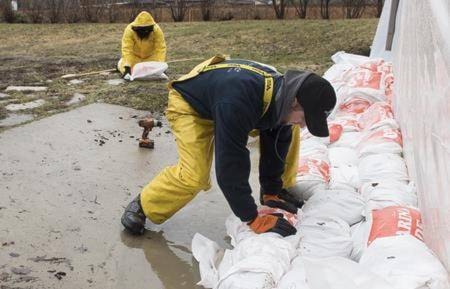Quebec’s deputy premier and public safety minister is urging those affected by flooding to exercise extreme caution and vigilance as rising water levels continue to wreak havoc on the province.
“Do not take unnecessary risks, please,” Genevieve Guilbault said at the Ti-Oui Snack Bar in Saint-Raymond on Saturday.
Regional liaison officers for the Canadian Armed Forces are deployed in five districts and prepared to assist residents, she said: Outaouais; Montreal, Laurentians and Lanaudiere; Monteregie and Estrie; Quebec City; and Chaudiere-Appallaches.
Guilbault offered her condolences to the family of Louise Seguin Lortie, who died early Saturday morning after driving her car into a massive sinkhole caused by flooding in the Outaouais region.
The accident left the 72-year-old’s sedan upside down in a swollen stream after rising river levels swept away part of the road in the overnight, police said.
Sgt. Martin Fournel of the MRC des Collines police said a pair of witnesses parked near the washout tried unsuccessfully to warn the driver as she approached.
“That lady, who was driving by herself on that road, fell into a sinkhole basically because of the flooding. There was a culvert that was not there anymore, so the road was cut in half and she was not able to brake and avoid the accident,” Fournel told The Canadian Press.
The woman was taken to hospital but pronounced dead soon after, he said.
The accident occurred at about 3:30 a.m. in the Municipality of Pontiac, about 30 kilometres northwest of Ottawa.
Pontiac, which sits along the Ottawa River, is one of at least three municipalities in the Outaouais region to declare states of emergency, along with Saint-Andre-Avellin and Val-des-Monts. The city of Trois-Rivieres is also under a state of emergency.
Six major floods have already been identified by Urgence Quebec, potentially affecting tens of thousands of residents: the Chaudiere River in Saint-Georges; Saint-Joseph, Scott and Vallee-Jonction in Beauce; and Deux-Montagnes Lake at Rigaud and Quesnel Bay.
In Beauceville, about 90 kilometres south of Quebec City, officials have asked the Canadian Armed Forces for assistance, with military vehicles en route to help with evacuations ordered by the municipality.
Earlier this week, the Chaudiere River burst its banks and flooded a large part of downtown. Officials called it the worst flooding since 1971, with 230 homes and businesses flooded.
In Saint-Raymond, about 60 kilometres northwest of the provincial capital, 24 seniors in three residences have been moved to higher ground as the Ste-Anne River continues to rise.
A local dam gave way Saturday, said Mayor Daniel Dion, prompting concerns about flooding.
“The problem today is that there is a lot of ice. If they clog our channels the water will have no space to circulate and that’s where it overflows,” he said.
Dion said he expects the high-water mark to come Sunday evening.
As of noon Saturday, there were 72 flooded residences, 53 isolated residences and 197 evacuees across the province, according to the most recent Urgence Quebec bulletin.
The most affected areas are Beauce — south of Quebec City — and Rigaud, west of the Island of Montreal.
Provincial police are checking up on residents door to door in Beauceville and Rigaud, where the Surete du Quebec (SQ) have set up command posts, said Sgt. Marie-Michele Moore.
William Bradley, whose house in Rigaud sits on a street that hugs the Ottawa River, said he’s filled several hundred city-supplied sandbags this week. He’s stacked them four-high around doors and windows, wrapping the makeshift barriers in polyethylene.
“It’s still coming up, coming up,” said Bradley, 72. “What you’ve got now are people…leaving their houses as the water levels rise.”
Bradley said flooding two years ago caused about $100,000 in damage to the ceramics equipment he stores at home for his small business.
“We’ll stay as long as we have gas for the generator. We’ve got a boat — my daughter bought a boat and a motor for us in 2017,” he told The Canadian Press. “By the way, never buy a boat during a flood season. It gets pricey.”
About 40 millimetres of rain have fallen on the Montreal area since Thursday, with five to 10 millimetres more expected Saturday, according to Environment Canada. Rainfall warnings have been lifted, but water levels were already high and were expected to rise sharply with warm temperatures and snowmelt runoff.
Guilbault has said the province will also allow stores — usually closed on Easter Sunday — to remain open this weekend so residents can stock up on supplies.
Thomas Blanchet, a spokesman for the province’s public safety department, said residents should be ready for a sharp spike in water levels that could come quickly, and he implored them to follow the instructions of local officials.
In Laval, just north of Montreal, officials said some 1,500 homes and businesses were under flood watch. In Montreal, Mayor Valerie Plante toured various parts of the city under flood watch.
Plante said the boroughs were well prepared, having learned lessons from record floods two years ago.
“We’re putting in all our energy, but in the end Mother Nature decides,” Plante said.
In a statement, the City of Laval said it had distributed sandbags to 900 homes and knocked on 550 doors to make sure people were safe, as concern rises along with water levels in the Thousand Islands and Prairies rivers.
Quebec City and the Gaspe Peninsula can expect up to 30 millimetres of rainfall this weekend, said Environment Canada meteorologist Andre Cantin.
“That will help the snow to melt again, and we do not expect the river will be able to go down for at least 48 hours,” he said Saturday morning.
The Canadian Press
